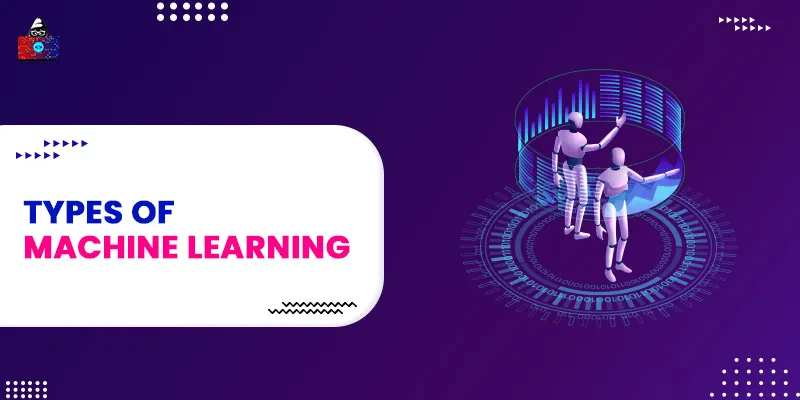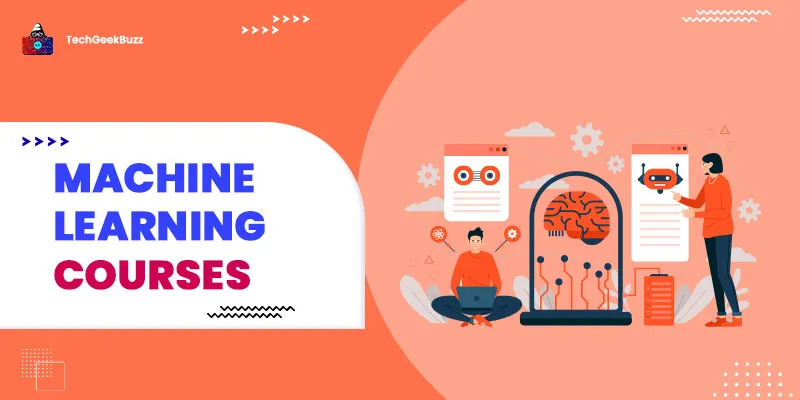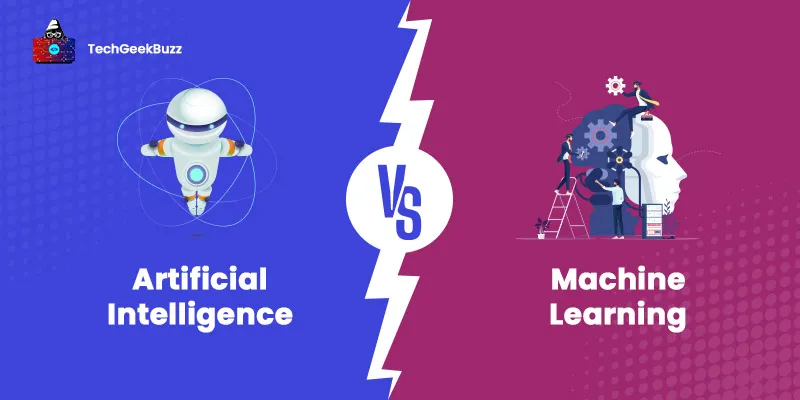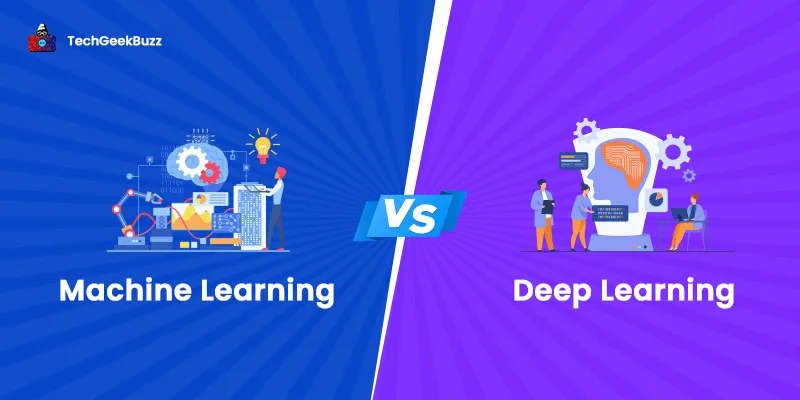Machine learning is one of the most revolutionary and game-changing technologies. It is making human lives easier than ever before and helping the world move into an age of automation. Almost every application or software product emerging in this technological era has an element of artificial intelligence (AI) and machine learning (ML).
Both AI and ML have significantly impacted every industry type, including healthcare, business, education, transport, manufacturing, and entertainment. ML has gained massive attention in the last decade, all thanks to the availability of limitless quantities of data, affordable data storage solutions, and less expensive and powerful data processing tools. Since companies and organizations have large volumes of data with them, machine learning helps them to automate the process of data analysis.
This article aims to familiarize you with what exactly machine learning is and its different types. Also, we will help you understand how each machine learning type works with an example. So, let us start with an overview of machine learning.
What is Machine Learning?
Machine learning is a branch of computer science and a subset of artificial intelligence. It focuses on leveraging data and various algorithms to enable systems to simulate the way humans learn and become more accurate at predicting outcomes. Also, machine learning uses historical data to learn and predict new output values.
Whenever we feed a system with some historical data, it learns from that data, identifies patterns and trends, and predicts accurate outcomes without human intervention. Therefore, we can say that machine learning is the study of computers that leverage historical data to find meaningful insights without being explicitly instructed to do so.
For example, let us say that a machine has to predict whether a particular customer will buy a specific product this year or not. The machine will predict it by looking at past experiences, i.e., the customer’s previous purchasing behavior. If the customer buys the product every year, there is a high possibility that they will buy it this year. This is how machine learning works.
Types of Machine Learning
There are three types of machine learning, namely supervised, unsupervised, and reinforcement.
- Supervised Learning: A type of machine learning that requires input-output pairs as input data to predict the output for a given input.
- Unsupervised Learning: A type of machine learning that uses unlabeled data and discovers hidden patterns and structures from it.
- Reinforcement Learning: A feedback-based machine learning where an agent performs actions in an environment and behaves according to the feedback received from those actions.
Now, let us discuss each of these machine learning types in detail below.
1. Supervised Learning
Supervised learning is a type of machine learning where machines are trained with labeled data, and based on this data, machines predict the output for any given input. Here, the labeled data implies some input data tagged with the correct output.
A machine is fed with this labeled training data that acts as a teacher or a supervisor and trains the machine to predict the accurate output. Therefore, we can say that the concept of supervised machine learning is analogous to student learning under the supervision of a teacher.
To put it simply, supervised machine learning involves training a machine with a set of inputs with their respective outputs to anticipate the accurate outcome when any new input data is provided. Some common real-world applications of supervised machine learning include spam filtering, risk assessment, image classification, and fraud detection.
How Does Supervised Learning Work?
Let us understand supervised machine learning with one example. Consider a dataset having data of the blocks of different shapes, like square, rectangle, triangle, hexagon, and other polygons.
We need a model that can accurately identify the shape of blocks and classify them accordingly. The first step in supervised learning is to train a model or a machine with the input data and its corresponding output. In our example, we have to train the model for each shape, as described below:
- If an object has three sides, it is a triangle.
- If an object has four sides with all equal sides, it is a square.
- If an object has five sides, it is a pentagon.
Similarly, we need to train the model with all shapes, like a hexagon, pentagon, octagon, etc. After training the model, we need to test it using the test set and check whether it can identify the shape of a block. Now the model is fully trained with all the shapes of blocks, whenever it finds any new block, it classifies that block depending on the number of sides and predicts its shape.
Types of Supervised Machine Learning
There are two types of supervised learning, namely classification, and regression.
- Classification
Classification categorizes the test data into specific categories. In our example, a classification algorithm separates a square from a triangle or a triangle from a hexagon, i.e., to separate each shape from every other shape. Some popular classification algorithms include support vector machines (SVM), decision trees, linear classifiers, random forests, and k-nearest neighbors.
- Regression
Regression is used to understand the relationship between dependent and independent variables. It is used when the output is a real value, such as revenue. Some popular regression algorithms include linear regression, logistic regression, and polynomial regression.
Pros and Cons of Supervised Learning
The following are the pros and cons of supervised machine learning:
Pros
- Supervised learning makes it easier to determine what and how many classes we want to have, depending upon the given data set .
- The input data is labeled and well-known.
- The results predicted by supervised machine learning are more accurate and reliable than unsupervised machine learning.
Cons:
- Supervised learning can be complicated since it requires very well-labeled input data.
- It does not take place in real-time like unsupervised learning.
2. Unsupervised Learning
Unlike supervised learning, unsupervised learning does not use labeled datasets. Instead, an unsupervised learning model itself determines the hidden patterns and trends from the given data set without any human intervention. It is referred to as unsupervised learning since there is no human supervision and involves self-organized learning.
In supervised learning, we provide the model with a set of input and its corresponding output to predict the outcome for the given dataset. However, this is not the case in unsupervised learning. In unsupervised learning, we provide the model only with the input data and not its corresponding output.
Some typical real-world examples of unsupervised learning include pattern recognition, data mining, data analytics, and recommender engines.
How Does Unsupervised Learning Work?
Let us take one simple example to understand how unsupervised learning works. Consider we have the input dataset containing the images of several cats and dogs. We need a machine or a model that can group the cats into one group and dogs into another without any labeled data. The unlabeled input data is fed to a model.
Firstly, the model analyzes the unlabeled input data to uncover hidden patterns from the data. Later, it selects a specific and suitable algorithm to divide the data objects into groups depending on their similarities and differences.
In our example, the model analyzes the data set containing the images of cats and dogs. It uses a suitable algorithm to divide cats into one group and dogs into another. Since no input-output values are provided to the model, it divides cats and dogs into separate groups depending on their similarities and differences.
Types of Unsupervised Learning
There are two types of unsupervised machine learning, namely clustering and association.
- Clustering
Clustering groups the data items from the unlabeled data set into clusters. Each cluster has data items with the highest commonalities. Typical clustering algorithms include K-means clustering and hierarchical clustering.
- Association
An associate rule in unsupervised learning identifies the relationship between variables in the given data set. It is widely employed in market basket analysis, a data mining technique used by retailers to determine the association between products. For instance, customers are more likely to buy butter with bread.
Pros and Cons of Unsupervised Learning
The following are the pros and cons of unsupervised machine learning:
Pros
- Unsupervised learning is less complex than supervised learning since it does not involve any supervision.
- It can determine what human minds cannot.
- The result of unsupervised learning can result in a new business venture.
- It is easier to obtain unlabeled data.
Cons
- The results produced by unsupervised learning are not accurate and reliable compared to supervised learning.
- It does not consider spatial relationships in the data.
3. Reinforcement Learning
Reinforcement learning is the type of machine learning that involves an intelligent agent interacting with the environment and learning to perform actions within that. Alternatively, we can define reinforcement learning as a feedback-based machine learning technique where an agent performs various actions in an environment and behaves according to the results of those actions.
An agent gets a positive response for every good action and a negative response for every bad action. Unlike supervised learning, reinforcement learning does not require labeled data. An agent learns itself and performs actions using the feedback it receives. Hence, an agent in reinforcement learning is bound to learn by its experiences.
Reinforcement learning is used in a situation where the decision-making process is sequential, and the goal is long-term. We can use reinforcement learning for building robots for industrial automation and building a machine learning model for data processing.
How Does Reinforcement Learning Work?
Let us take one example to understand the working of reinforcement learning. Before proceeding with the example, let us first understand two important terminologies, namely environment, and agent.
- Environment: An environment can be anything, like a maze, room, football ground, etc.
- Agent: An agent can be an AI robot that performs actions in an environment.
In our example, let us take a maze as the environment. An agent has to reach the reward with several hurdles in the path. Consider the below figure. The fig shows that we have a robot, fire, and diamond. The robot needs to collect the reward, i.e., diamond, with fire as hurdles in the path. It has to choose the best possible path to reach the diamond with the least hurdles.
The robot receives positive feedback for every right step and negative feedback for every wrong step. Depending upon the feedback the robot receives, it performs actions in the maze and reaches the diamond by learning on its own.
Types of Reinforcement Learning
There are two types of reinforcement learning, namely positive and negative. Let us understand both these types in detail below:
- Positive Reinforcement Learning
Positive reinforcement learning is defined as an event occurring due to specific behavior of an agent, and that event improves the strength and frequency of the agent’s behavior. Alternatively, we can say that the event has a positive effect on the agent’s behavior.
- Negative Reinforcement Learning
Negative reinforcement learning is defined as the increase in the strength of an agent’s behavior because a negative condition is avoided or stopped.
Pros and Cons of Reinforcement Learning
The following are the pros and cons of reinforcement learning:
Pros
- Reinforcement learning is beneficial in solving complex problems that cannot be solved using conventional machine learning types, namely supervised and unsupervised machine learning.
- It is ideal for achieving long-term results, which are difficult to achieve using conventional machine learning types.
- The reinforcement learning model does not require human supervision and learns from its own experiences.
- Reinforcement learning models can outperform humans in multiple tasks. One example of this is DeepMind’s AlphaGo program. It is the reinforcement learning model that beat the world champion Lee Sedol in the game of Go.
- A reinforcement learning model is analogous to how human beings learn. Hence, it produces relatively perfect and more accurate outcomes than other conventional machine learning types.
Cons:
- It is not ideal for solving simple problems.
- It requires a lot of data and computation.
- Too much reinforcement can overload the states, which may diminish the outcomes.
Supervised vs Unsupervised vs Reinforcement Learning
The following table highlights the key differences between supervised, unsupervised, and reinforcement learning.
| Criteria | Supervised Learning | Unsupervised Learning | Reinforcement Learning |
| Definition | Supervised learning depends on labeled data to predict the outcomes. | Unsupervised learning uses unlabeled data, and it uncovers hidden patterns and trends from the data set without any human intervention. | Reinforcement learning involves training models or machines to make a sequence of decisions. |
| Type of Data Used | It uses labeled data. | It depends on unlabeled data. | There is no predefined data in this type of machine learning. |
| Types of problems | Classification and Regression. | Clustering and Association. | Exploitation and Exploration. |
| Supervision | It requires supervision. | It does not require supervision. | No supervision is involved. |
| Algorithms | Support Vector Machine (SVM), K-nearest neighbor, linear classifiers, and Random forests. | K-means, C-means, and Apriori. | Q-learning and SARSA. |
| Objective | Supervised learning predicts accurate outcomes. | It uncovers underlying patterns and trends from data sets. | It learns a series of actions. |
| Application | Spam filtering, risk assessment, fraud detection, and image classification. | Pattern recognition, recommender engines, data mining, and data analytics. | Self-driving cars and gaming. |
Conclusion
The three types of machine learning, i.e., supervised, unsupervised, and reinforcement learning, intend to instruct machines and make them capable of performing various tasks. Supervised machine learning involves labeled data to predict outcomes.
On the flip side, unsupervised machine learning uses unlabeled data to discover hidden patterns and structures from datasets. When it comes to reinforcement learning, it performs actions in an environment based on the feedback received for past actions.
Lastly, we hope this article helped you develop a better understanding of machine learning and its various types.
People are also reading:
- Best Machine Learning Certifications
- Best Machine Learning Projects
- How to Implement Classification In Machine Learning?
- Machine Learning Applications
- Machine Learning Algorithms
- Best Machine Learning Frameworks
- Machine Learning Interview Questions
- Decision Tree in Machine learning
- Data Science vs Machine Learning
- Introduction to Machine Learning




